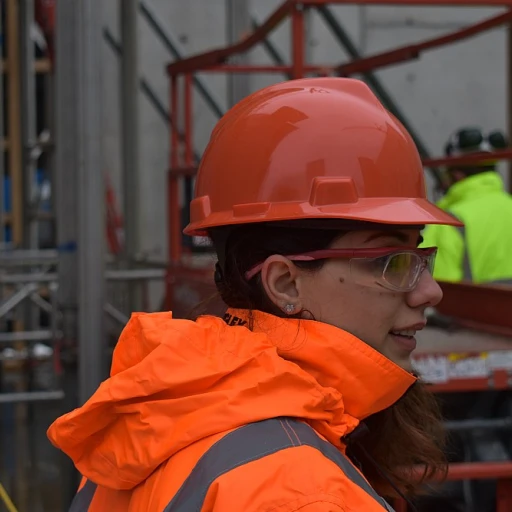Understanding Team Dynamics in HR Tech
Recognizing Team Patterns and Interactions
Understanding the dynamics of a team within HR tech is vital for achieving high performance. Teams function as intricate ecosystems, where individual contributions and interactions significantly affect the overall output. To begin building an effective team, it's essential to recognize and analyze the patterns in how team members interact with one another and the environment. This recognition facilitates improvements in collaboration and allows leaders to tailor strategies that align with both team goals and organizational goals.
The Role of Trust and Psychological Safety
A successful and productive team thrives on the foundation of trust and psychological safety. When team members feel secure in expressing their thoughts and ideas without fear of judgment, open communication naturally follows. This open dialogue is a critical element in fostering team effectiveness and ensuring that all members are committed to achieving high performance. Encouraging a culture where employees feel valued and respected fortifies overall team development.
Key Characteristics of Effective Communication
Effective teams are built on robust communication channels. Regular check-ins and transparent updates promote an inclusive environment, allowing team members to stay informed and engaged. To improve team performance, leaders must promote a culture of continuous feedback and development. By emphasizing clear exchanges and responses, leaders can enhance the team's ability to work towards shared goals.
Aligning Team and Organizational Goals
The alignment of team objectives with broader organizational goals is a critical factor in driving team success. Leaders should work closely with their teams to set realistic and achievable goals that reflect both individual aspirations and corporate visions. This alignment not only nurtures a strong sense of purpose but also ensures that the efforts of all team members contribute towards the larger mission. For further reading on team evaluations, you can explore
enhancing employee evaluations with AI-driven performance review generators.
Key Strategies for Building Effective Teams
Fostering Cohesion and Collaboration
Understanding the intricacies of building effective teams is crucial for fostering cohesion and collaboration. Leaders play an integral role in setting the stage for a high performing team by clearly defining team goals and creating a team culture that aligns with organizational goals. Effective communication is key; open communication channels ensure that team members feel heard, respected, and valued, which in turn builds trust among team members.
Encouraging Psychological Safety
Psychological safety is another pivotal element in building effective teams. When team members feel safe to express their ideas and challenges without fear of negative repercussions, the environment becomes more innovative and solutions-oriented. This atmosphere not only stimulates team development but also enhances team performance. Leaders who prioritize regular check ins and transparent feedback mechanisms contribute significantly to creating a culture where employees are encouraged to speak up and actively participate.
Utilizing Diverse Talents
Embracing diversity and utilizing the varying talents within a team can lead to higher team effectiveness. Each team member brings unique skills and perspectives, and leveraging these can lead to innovative solutions and a competitive edge. High performing teams often exhibit a mix of complementary skills that, when combined effectively, lead to exceptional performance outcomes.
For more insights on fostering effective teams, consider exploring this resource on
AI-driven performance review generators. This technology can significantly contribute to team development and alignment, leading to sustained success.
Leveraging Technology for Team Success
Transforming Team Success with HR Technology
The integration of advanced HR technology is a pivotal element in building high-performing teams. By leveraging specific tools and platforms, team leaders can enhance team effectiveness significantly, aiding in the overall performance and development of their teams.
One of the fundamental aspects of utilizing technology is enhancing communication. With tools that facilitate open communication, teams can easily share ideas and feedback, thus promoting psychological safety and trust among all team members. This framework allows members to feel more valued, fostering a culture where they can fearlessly collaborate and commit to team goals.
Additionally, modern HR tools provide detailed data and analytics that help in monitoring team performance. Leaders can set clear objectives that align with organizational goals and perform regular check-ins to ensure all team members are aligned. These insights enable leaders to make informed decisions that guide the team towards improved performance and success.
Collaboration platforms also play a significant role in maintaining team culture. They enable the team to schedule tasks efficiently, track project progress, and ensure everyone is on the same page, which is instrumental in sustaining high performance across the board.
Through the strategic use of HR technology, leaders not only simplify the team-building process but also set a robust foundation for consistent high performance and successful development of their teams. Embracing these tools transforms how teams work, as they build a cohesive environment where members are empowered to excel.
Leadership Styles that Foster Team Growth
Leadership Characteristics that Drive Team Growth
Developing a high-performing team goes beyond merely assembling talented individuals; it requires leaders who are adept at fostering collaboration and open communication. When leaders possess the right skills and approach, they can effectively guide their teams toward achieving organizational goals.
Effective leaders are those who can build trust among team members. Trust acts as a foundation for psychological safety, where team members feel comfortable sharing ideas, taking risks, and engaging in creative problem-solving. Leaders who prioritize transparent communication and regular check-ins with team members can significantly impact team culture and build an environment where employees thrive.
Impact of Communication on Team Development
Open communication within teams is another hallmark of strong leadership. By promoting open dialogue, leaders can ensure that all members feel valued and heard, leading to a more engaged and motivated workforce. This is particularly crucial in remote or hybrid work setups, where maintaining communication can be challenging.
Moreover, effective communication helps in aligning team goals with the broader organizational objectives. When team members have clarity on their roles and responsibilities, coupled with a shared understanding of the team's goals, they are more likely to work collaboratively, leading to high performance and team effectiveness.
Leadership Styles and Their Influence
Different leadership styles can affect the dynamics of a team in various ways. Transformational leaders, for instance, inspire team members by connecting individual aspirations with overarching team goals. They encourage innovation and adaptability, key components in building effective teams.
Conversely, transactional leaders focus on structure and clear guidelines. They offer rewards for high performance and set clear expectations. Both of these styles can be effective depending on the team's maturity and specific needs.
Ultimately, the best leaders are those who adapt their style to the current team dynamics and challenges. They continuously refine their approach to enable team development and success, turning challenges into opportunities for growth and learning. By embodying these leadership traits, leaders can ensure that their teams are not only performing well but also evolving to meet the ever-changing demands of the business landscape.
Overcoming Challenges in Team Management
Overcoming Common Obstacles in Team Management
Building high performing teams is a rewarding yet challenging endeavor. In an organization's journey towards fostering team effectiveness, several hurdles can arise. However, with thoughtful strategies and an emphasis on open communication, these obstacles can be transformed into opportunities for team development.
One of the primary challenges is ensuring that all team members are aligned with the organizational goals. Misalignment can lead to confusion, reducing the team's overall performance. To combat this, effective leaders hold regular check-ins to reiterate team goals and assess each member's understanding of their role in the grand scheme. This practice not only strengthens the team's focus but also boosts morale by making members feel valued and heard.
Another notable hurdle is fostering trust and psychological safety among team members. When trust is lacking, collaboration suffers, and employees may hesitate to share ideas or feedback, stifling innovation and team growth. To build trust, leaders should cultivate a team culture that encourages candid communication and inclusivity. Emphasizing psychological safety as a core aspect of team dynamics ensures that every team member feels safe to voice their thoughts without fear of repercussion.
Communication barriers often impede the development of effective teams. A central tenet of team effectiveness is ensuring that communication flows smoothly and freely among members. Leaders play a crucial role in dismantling these barriers by promoting an open-door policy and utilizing technology that facilitates real-time, transparent communication.
Lastly, effective team management necessitates addressing conflicts proactively. Conflict, while inevitable, can be a catalyst for growth if managed properly. Leaders should equip themselves with strategies to mediate disputes and emphasize conflict resolution techniques within the team. Encouraging team members to approach disagreements with empathy and a focus on mutual understanding can transform potential disruptions into opportunities for strengthening the team.
By addressing these common challenges head-on and incorporating them into the core of team-building strategies, organizations can pave the way for high performance and team success.
Evaluating and Enhancing Team Performance
In the complex landscape of team building and leadership, understanding how to measure team performance and success is crucial for any organization aiming for high performance.
Performance metrics are a foundational tool for assessing team effectiveness. To begin, consider setting clear, attainable goals for team members. These goals should align with the broader organizational objectives, creating a cohesive path towards collective success. Regular check-ins are essential to gauge progress and keep everyone on track.
Implementing Transparent Evaluation Processes
A transparent evaluation process helps build a culture of trust and open communication among team members. Performance reviews should focus not only on the outcomes but also on the team dynamics, collaboration, and communication effectiveness. Creating an environment where employees feel safe to share feedback can significantly enhance team development and psychological safety.
When evaluating team performance, leaders must prioritize continuous feedback over periodic reviews. Encourage a culture where feedback is part of everyday work life. Effective leaders bridge gaps through consistent dialogue, offering team members the opportunity to reflect and grow.
Balancing Quantitative and Qualitative Metrics
While quantitative metrics such as task completion rates, project deadlines, and productivity levels offer tangible insights into team effectiveness, qualitative metrics must not be overlooked. Consider assessing factors like employee satisfaction, team chemistry, and the level of psychological safety perceived by team members.
A well-rounded evaluation strategy takes into account the multi-dimensional nature of team work. By combining both quantitative and qualitative assessments, leaders can gain a holistic view of team performance, which is critical to fostering high-performing teams.
Leveraging Technology for Assessment
Understanding and leveraging the right technological solutions can streamline the process of measuring team performance. Tools designed to track progress, share feedback, and facilitate communication are crucial for building effective teams. What’s more, technology can offer insights into areas needing improvement, thereby boosting team development.
In conclusion, measuring team performance involves a balance of clear goal-setting, transparent communication, and leveraging the right tools to capture both quantitative and qualitative data. By doing so, leaders can drive teams towards success, ensuring that every member feels valued and motivated to contribute to the team's goals.














